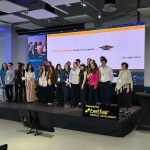Dr. Bonita Sharif, Associate Professor, University of Nebraska, USA: How Gaze Differs Between Natural Text and Source Code for Novices and Experts
În cadrul Seminarului de Inovare și Dezvoltare din cadrul Departamentului de Informatică, Dr. Bonita Sharif, Associate Professor in cadrul Department of Computer Science and Engineering at University of Nebraska - Lincoln, Lincoln, Nebraska USA va susține în data de 9.03.2022 o prelegere intitulata How Gaze Differs Between Natural Text and Source Code for Novices and Experts.
Abstract: Code reading is an important skill in programming. Inspired by the linearity that people exhibit while natural language text reading, we designed local and global gaze-based measures to characterize linearity (left-to-right and top-to-bottom) in reading source code. Unlike natural language text, source code is executable and requires a specific reading approach. To validate these measures, we compared the eye movements of novice and expert programmers who were asked to read and comprehend short snippets of natural language text and Java programs. Our results show that novices read source code less linearly than natural language text. Moreover, experts read code less linearly than novices. These findings indicate that there are specific differences between reading natural language and source code, and suggest that non-linear reading skills increase with expertise.
Evenimentul se va desfășura online începând cu ora 18.30 pe platforma Microsoft Teams, la această adresă.
Bonita Sharif is an Associate Professor in the School of Computing specializing in Software Engineering at UNL. Research interests are in eye-tracking related to software engineering, biometric measures, human-computer interaction, empirical software engineering, emotional awareness, software traceability, and software visualization to support the maintenance of large systems. She serves as the Steering Committee chair for the ETRA conference. She also serves on numerous program committees including ICSE, ASE, ICSME, ICPC, and SANER.

















